PUMA's Corporate Social Responsibility Failure at Dongguan: Analysis
VerifiedAdded on 2020/03/16
|9
|1720
|32
Report
AI Summary
This report critically examines the corporate social responsibility (CSR) failures of PUMA at its subcontracting company, Dongguan Surpassing Shoe Co. Ltd., in China. The report highlights the detrimental working conditions, including excessive overtime, poor pay, and substandard living conditions, as revealed by China Labor Watch. It explores the objectives of the study, which include establishing reasons for the unethical conduct, providing ways to improve worker conditions, determining legal working hours, and suggesting how PUMA can engage in CSR to redeem its image. The literature review discusses the importance of value creation, PUMA's sustainability initiatives, and the historical context of the shoe industry in China. The methodology involves interviews, observations, and questionnaires to gather data from workers. The report concludes by emphasizing the need for PUMA to uphold workers' rights and ethical standards, and the responsibilities of labor authorities in China. The report includes a timeline for the project and a list of references.
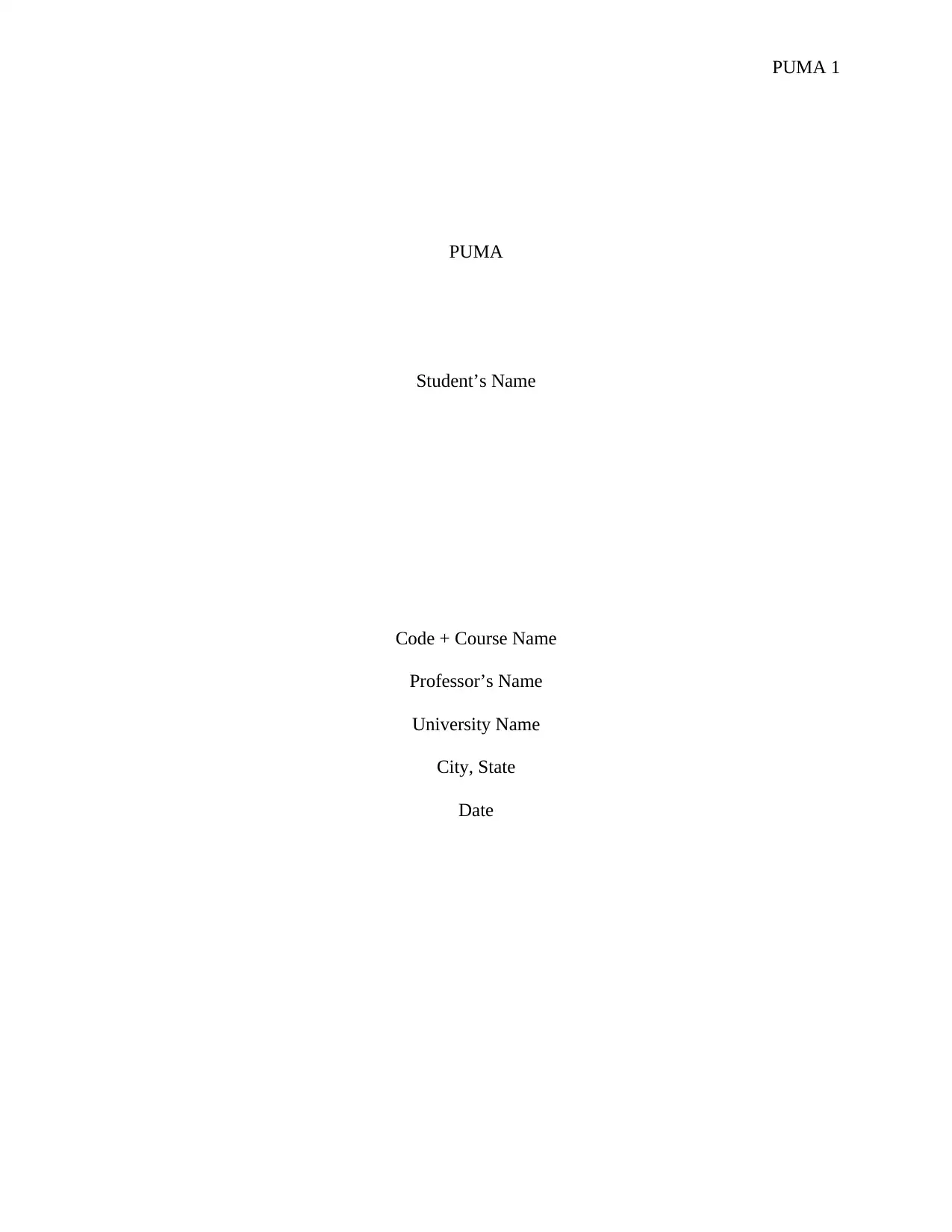
PUMA 1
PUMA
Student’s Name
Code + Course Name
Professor’s Name
University Name
City, State
Date
PUMA
Student’s Name
Code + Course Name
Professor’s Name
University Name
City, State
Date
Paraphrase This Document
Need a fresh take? Get an instant paraphrase of this document with our AI Paraphraser
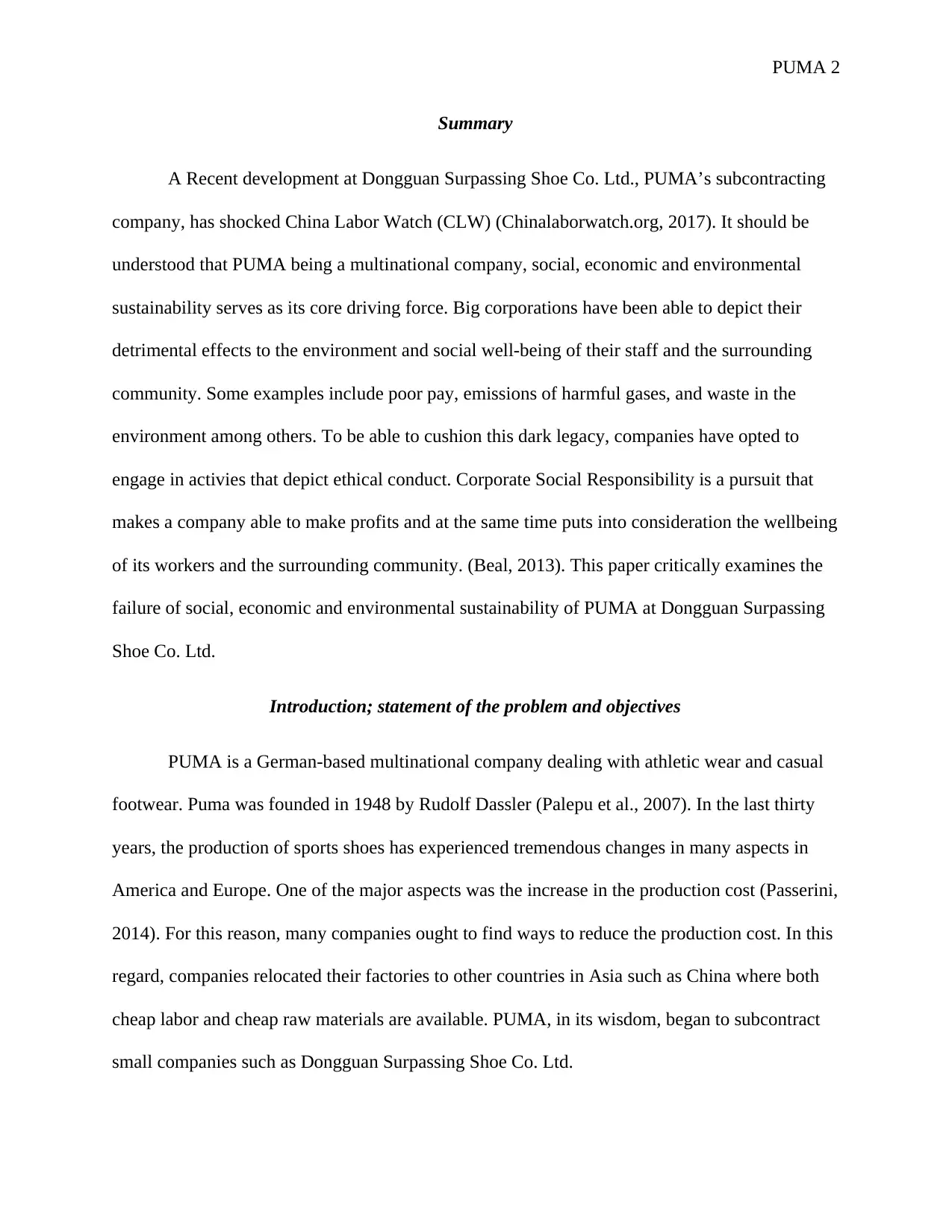
PUMA 2
Summary
A Recent development at Dongguan Surpassing Shoe Co. Ltd., PUMA’s subcontracting
company, has shocked China Labor Watch (CLW) (Chinalaborwatch.org, 2017). It should be
understood that PUMA being a multinational company, social, economic and environmental
sustainability serves as its core driving force. Big corporations have been able to depict their
detrimental effects to the environment and social well-being of their staff and the surrounding
community. Some examples include poor pay, emissions of harmful gases, and waste in the
environment among others. To be able to cushion this dark legacy, companies have opted to
engage in activies that depict ethical conduct. Corporate Social Responsibility is a pursuit that
makes a company able to make profits and at the same time puts into consideration the wellbeing
of its workers and the surrounding community. (Beal, 2013). This paper critically examines the
failure of social, economic and environmental sustainability of PUMA at Dongguan Surpassing
Shoe Co. Ltd.
Introduction; statement of the problem and objectives
PUMA is a German-based multinational company dealing with athletic wear and casual
footwear. Puma was founded in 1948 by Rudolf Dassler (Palepu et al., 2007). In the last thirty
years, the production of sports shoes has experienced tremendous changes in many aspects in
America and Europe. One of the major aspects was the increase in the production cost (Passerini,
2014). For this reason, many companies ought to find ways to reduce the production cost. In this
regard, companies relocated their factories to other countries in Asia such as China where both
cheap labor and cheap raw materials are available. PUMA, in its wisdom, began to subcontract
small companies such as Dongguan Surpassing Shoe Co. Ltd.
Summary
A Recent development at Dongguan Surpassing Shoe Co. Ltd., PUMA’s subcontracting
company, has shocked China Labor Watch (CLW) (Chinalaborwatch.org, 2017). It should be
understood that PUMA being a multinational company, social, economic and environmental
sustainability serves as its core driving force. Big corporations have been able to depict their
detrimental effects to the environment and social well-being of their staff and the surrounding
community. Some examples include poor pay, emissions of harmful gases, and waste in the
environment among others. To be able to cushion this dark legacy, companies have opted to
engage in activies that depict ethical conduct. Corporate Social Responsibility is a pursuit that
makes a company able to make profits and at the same time puts into consideration the wellbeing
of its workers and the surrounding community. (Beal, 2013). This paper critically examines the
failure of social, economic and environmental sustainability of PUMA at Dongguan Surpassing
Shoe Co. Ltd.
Introduction; statement of the problem and objectives
PUMA is a German-based multinational company dealing with athletic wear and casual
footwear. Puma was founded in 1948 by Rudolf Dassler (Palepu et al., 2007). In the last thirty
years, the production of sports shoes has experienced tremendous changes in many aspects in
America and Europe. One of the major aspects was the increase in the production cost (Passerini,
2014). For this reason, many companies ought to find ways to reduce the production cost. In this
regard, companies relocated their factories to other countries in Asia such as China where both
cheap labor and cheap raw materials are available. PUMA, in its wisdom, began to subcontract
small companies such as Dongguan Surpassing Shoe Co. Ltd.
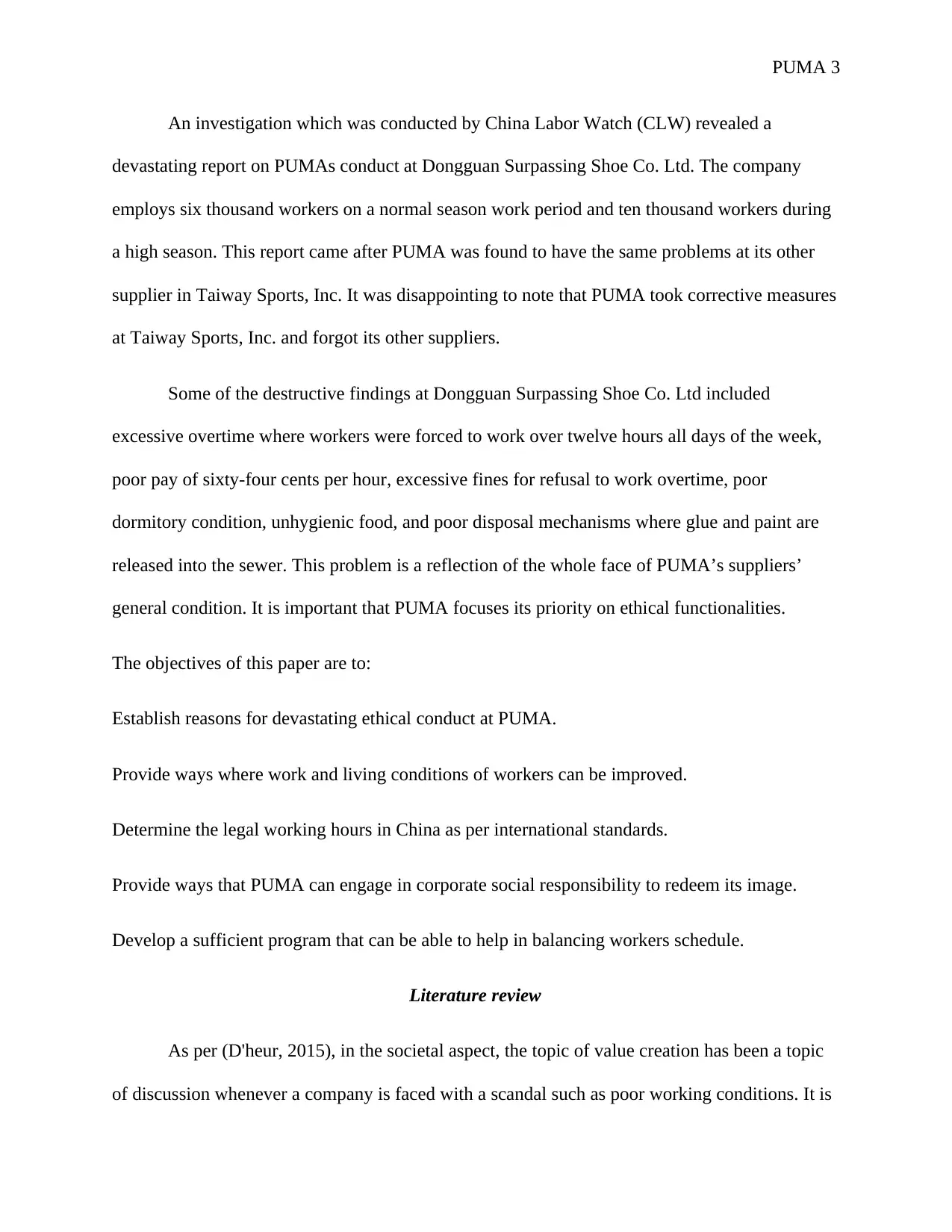
PUMA 3
An investigation which was conducted by China Labor Watch (CLW) revealed a
devastating report on PUMAs conduct at Dongguan Surpassing Shoe Co. Ltd. The company
employs six thousand workers on a normal season work period and ten thousand workers during
a high season. This report came after PUMA was found to have the same problems at its other
supplier in Taiway Sports, Inc. It was disappointing to note that PUMA took corrective measures
at Taiway Sports, Inc. and forgot its other suppliers.
Some of the destructive findings at Dongguan Surpassing Shoe Co. Ltd included
excessive overtime where workers were forced to work over twelve hours all days of the week,
poor pay of sixty-four cents per hour, excessive fines for refusal to work overtime, poor
dormitory condition, unhygienic food, and poor disposal mechanisms where glue and paint are
released into the sewer. This problem is a reflection of the whole face of PUMA’s suppliers’
general condition. It is important that PUMA focuses its priority on ethical functionalities.
The objectives of this paper are to:
Establish reasons for devastating ethical conduct at PUMA.
Provide ways where work and living conditions of workers can be improved.
Determine the legal working hours in China as per international standards.
Provide ways that PUMA can engage in corporate social responsibility to redeem its image.
Develop a sufficient program that can be able to help in balancing workers schedule.
Literature review
As per (D'heur, 2015), in the societal aspect, the topic of value creation has been a topic
of discussion whenever a company is faced with a scandal such as poor working conditions. It is
An investigation which was conducted by China Labor Watch (CLW) revealed a
devastating report on PUMAs conduct at Dongguan Surpassing Shoe Co. Ltd. The company
employs six thousand workers on a normal season work period and ten thousand workers during
a high season. This report came after PUMA was found to have the same problems at its other
supplier in Taiway Sports, Inc. It was disappointing to note that PUMA took corrective measures
at Taiway Sports, Inc. and forgot its other suppliers.
Some of the destructive findings at Dongguan Surpassing Shoe Co. Ltd included
excessive overtime where workers were forced to work over twelve hours all days of the week,
poor pay of sixty-four cents per hour, excessive fines for refusal to work overtime, poor
dormitory condition, unhygienic food, and poor disposal mechanisms where glue and paint are
released into the sewer. This problem is a reflection of the whole face of PUMA’s suppliers’
general condition. It is important that PUMA focuses its priority on ethical functionalities.
The objectives of this paper are to:
Establish reasons for devastating ethical conduct at PUMA.
Provide ways where work and living conditions of workers can be improved.
Determine the legal working hours in China as per international standards.
Provide ways that PUMA can engage in corporate social responsibility to redeem its image.
Develop a sufficient program that can be able to help in balancing workers schedule.
Literature review
As per (D'heur, 2015), in the societal aspect, the topic of value creation has been a topic
of discussion whenever a company is faced with a scandal such as poor working conditions. It is
⊘ This is a preview!⊘
Do you want full access?
Subscribe today to unlock all pages.

Trusted by 1+ million students worldwide
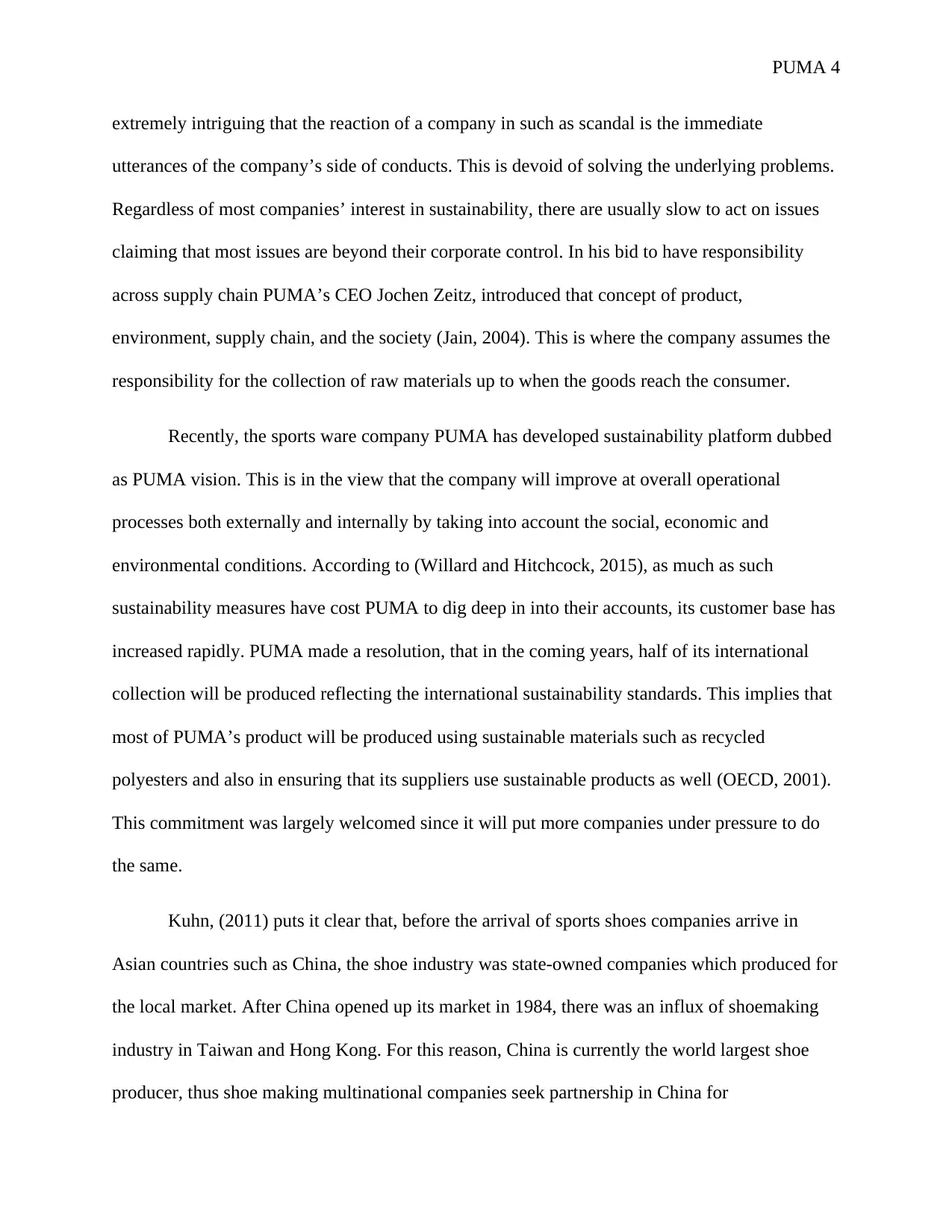
PUMA 4
extremely intriguing that the reaction of a company in such as scandal is the immediate
utterances of the company’s side of conducts. This is devoid of solving the underlying problems.
Regardless of most companies’ interest in sustainability, there are usually slow to act on issues
claiming that most issues are beyond their corporate control. In his bid to have responsibility
across supply chain PUMA’s CEO Jochen Zeitz, introduced that concept of product,
environment, supply chain, and the society (Jain, 2004). This is where the company assumes the
responsibility for the collection of raw materials up to when the goods reach the consumer.
Recently, the sports ware company PUMA has developed sustainability platform dubbed
as PUMA vision. This is in the view that the company will improve at overall operational
processes both externally and internally by taking into account the social, economic and
environmental conditions. According to (Willard and Hitchcock, 2015), as much as such
sustainability measures have cost PUMA to dig deep in into their accounts, its customer base has
increased rapidly. PUMA made a resolution, that in the coming years, half of its international
collection will be produced reflecting the international sustainability standards. This implies that
most of PUMA’s product will be produced using sustainable materials such as recycled
polyesters and also in ensuring that its suppliers use sustainable products as well (OECD, 2001).
This commitment was largely welcomed since it will put more companies under pressure to do
the same.
Kuhn, (2011) puts it clear that, before the arrival of sports shoes companies arrive in
Asian countries such as China, the shoe industry was state-owned companies which produced for
the local market. After China opened up its market in 1984, there was an influx of shoemaking
industry in Taiwan and Hong Kong. For this reason, China is currently the world largest shoe
producer, thus shoe making multinational companies seek partnership in China for
extremely intriguing that the reaction of a company in such as scandal is the immediate
utterances of the company’s side of conducts. This is devoid of solving the underlying problems.
Regardless of most companies’ interest in sustainability, there are usually slow to act on issues
claiming that most issues are beyond their corporate control. In his bid to have responsibility
across supply chain PUMA’s CEO Jochen Zeitz, introduced that concept of product,
environment, supply chain, and the society (Jain, 2004). This is where the company assumes the
responsibility for the collection of raw materials up to when the goods reach the consumer.
Recently, the sports ware company PUMA has developed sustainability platform dubbed
as PUMA vision. This is in the view that the company will improve at overall operational
processes both externally and internally by taking into account the social, economic and
environmental conditions. According to (Willard and Hitchcock, 2015), as much as such
sustainability measures have cost PUMA to dig deep in into their accounts, its customer base has
increased rapidly. PUMA made a resolution, that in the coming years, half of its international
collection will be produced reflecting the international sustainability standards. This implies that
most of PUMA’s product will be produced using sustainable materials such as recycled
polyesters and also in ensuring that its suppliers use sustainable products as well (OECD, 2001).
This commitment was largely welcomed since it will put more companies under pressure to do
the same.
Kuhn, (2011) puts it clear that, before the arrival of sports shoes companies arrive in
Asian countries such as China, the shoe industry was state-owned companies which produced for
the local market. After China opened up its market in 1984, there was an influx of shoemaking
industry in Taiwan and Hong Kong. For this reason, China is currently the world largest shoe
producer, thus shoe making multinational companies seek partnership in China for
Paraphrase This Document
Need a fresh take? Get an instant paraphrase of this document with our AI Paraphraser
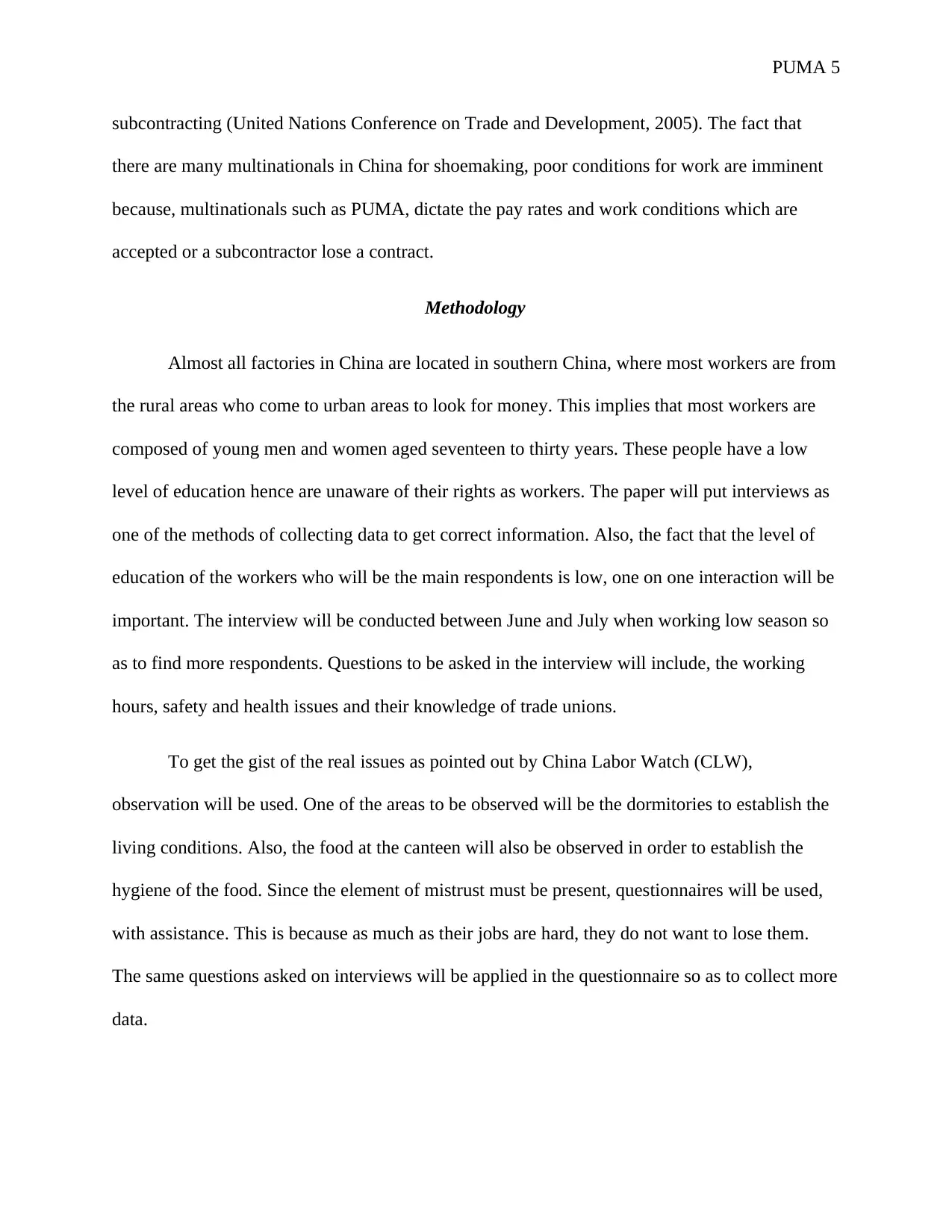
PUMA 5
subcontracting (United Nations Conference on Trade and Development, 2005). The fact that
there are many multinationals in China for shoemaking, poor conditions for work are imminent
because, multinationals such as PUMA, dictate the pay rates and work conditions which are
accepted or a subcontractor lose a contract.
Methodology
Almost all factories in China are located in southern China, where most workers are from
the rural areas who come to urban areas to look for money. This implies that most workers are
composed of young men and women aged seventeen to thirty years. These people have a low
level of education hence are unaware of their rights as workers. The paper will put interviews as
one of the methods of collecting data to get correct information. Also, the fact that the level of
education of the workers who will be the main respondents is low, one on one interaction will be
important. The interview will be conducted between June and July when working low season so
as to find more respondents. Questions to be asked in the interview will include, the working
hours, safety and health issues and their knowledge of trade unions.
To get the gist of the real issues as pointed out by China Labor Watch (CLW),
observation will be used. One of the areas to be observed will be the dormitories to establish the
living conditions. Also, the food at the canteen will also be observed in order to establish the
hygiene of the food. Since the element of mistrust must be present, questionnaires will be used,
with assistance. This is because as much as their jobs are hard, they do not want to lose them.
The same questions asked on interviews will be applied in the questionnaire so as to collect more
data.
subcontracting (United Nations Conference on Trade and Development, 2005). The fact that
there are many multinationals in China for shoemaking, poor conditions for work are imminent
because, multinationals such as PUMA, dictate the pay rates and work conditions which are
accepted or a subcontractor lose a contract.
Methodology
Almost all factories in China are located in southern China, where most workers are from
the rural areas who come to urban areas to look for money. This implies that most workers are
composed of young men and women aged seventeen to thirty years. These people have a low
level of education hence are unaware of their rights as workers. The paper will put interviews as
one of the methods of collecting data to get correct information. Also, the fact that the level of
education of the workers who will be the main respondents is low, one on one interaction will be
important. The interview will be conducted between June and July when working low season so
as to find more respondents. Questions to be asked in the interview will include, the working
hours, safety and health issues and their knowledge of trade unions.
To get the gist of the real issues as pointed out by China Labor Watch (CLW),
observation will be used. One of the areas to be observed will be the dormitories to establish the
living conditions. Also, the food at the canteen will also be observed in order to establish the
hygiene of the food. Since the element of mistrust must be present, questionnaires will be used,
with assistance. This is because as much as their jobs are hard, they do not want to lose them.
The same questions asked on interviews will be applied in the questionnaire so as to collect more
data.
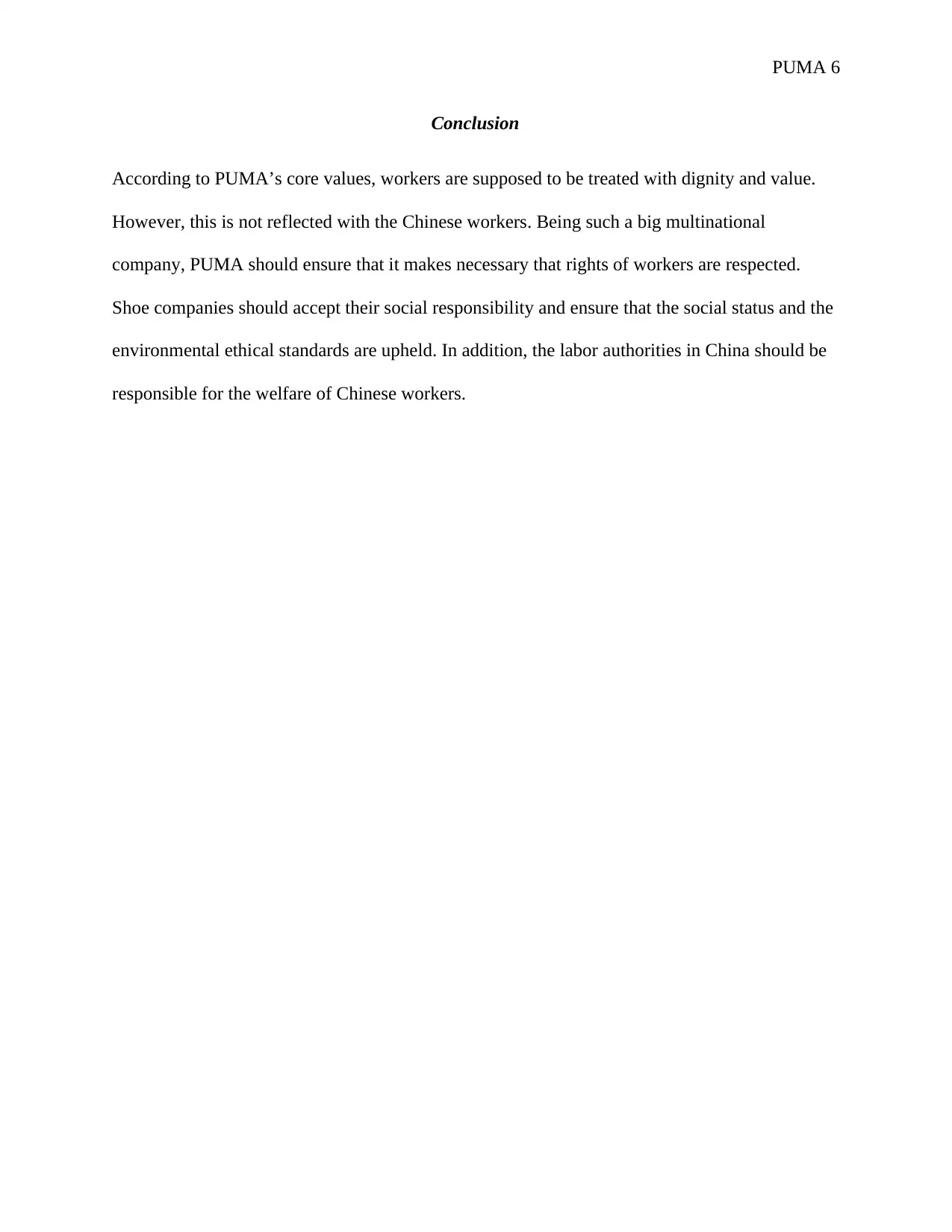
PUMA 6
Conclusion
According to PUMA’s core values, workers are supposed to be treated with dignity and value.
However, this is not reflected with the Chinese workers. Being such a big multinational
company, PUMA should ensure that it makes necessary that rights of workers are respected.
Shoe companies should accept their social responsibility and ensure that the social status and the
environmental ethical standards are upheld. In addition, the labor authorities in China should be
responsible for the welfare of Chinese workers.
Conclusion
According to PUMA’s core values, workers are supposed to be treated with dignity and value.
However, this is not reflected with the Chinese workers. Being such a big multinational
company, PUMA should ensure that it makes necessary that rights of workers are respected.
Shoe companies should accept their social responsibility and ensure that the social status and the
environmental ethical standards are upheld. In addition, the labor authorities in China should be
responsible for the welfare of Chinese workers.
⊘ This is a preview!⊘
Do you want full access?
Subscribe today to unlock all pages.

Trusted by 1+ million students worldwide
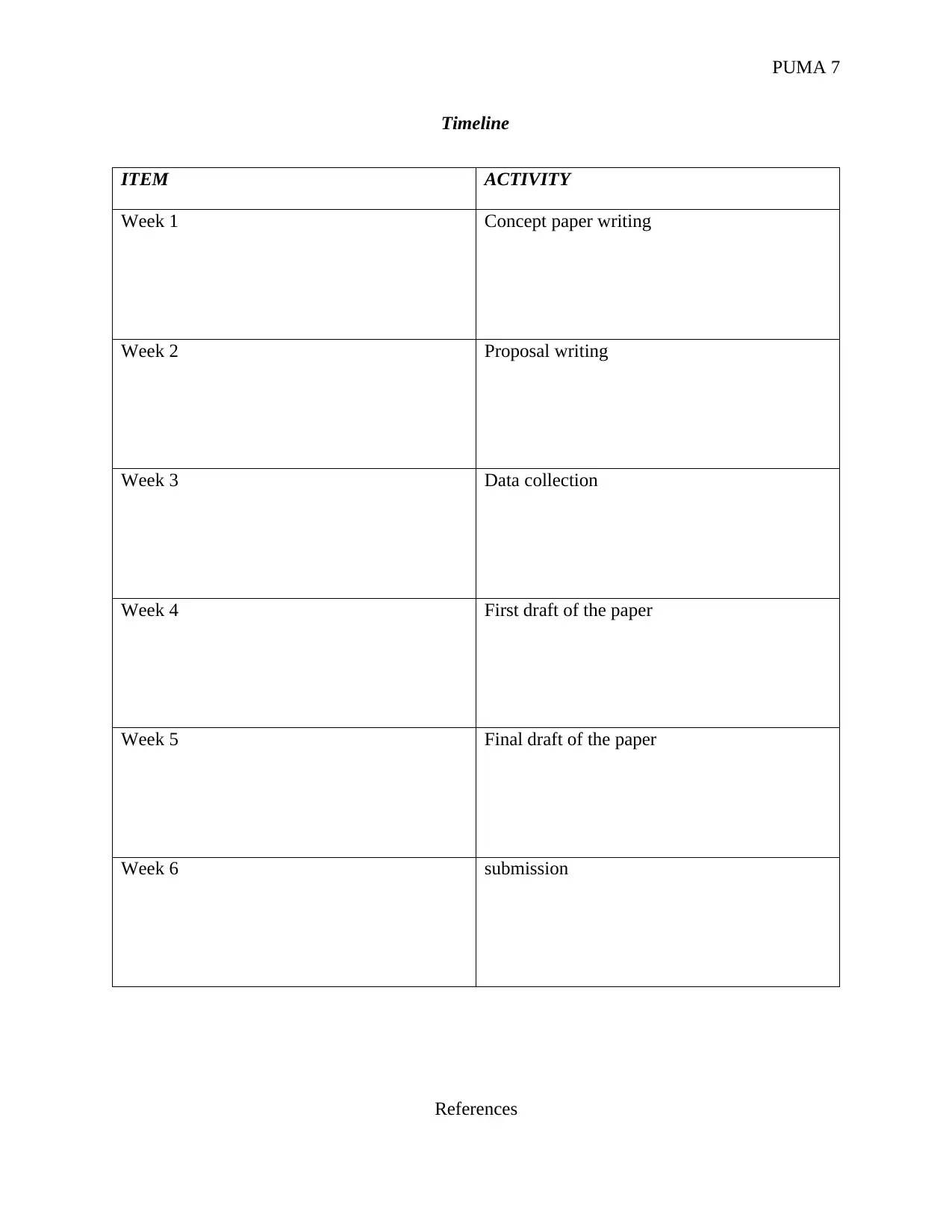
PUMA 7
Timeline
ITEM ACTIVITY
Week 1 Concept paper writing
Week 2 Proposal writing
Week 3 Data collection
Week 4 First draft of the paper
Week 5 Final draft of the paper
Week 6 submission
References
Timeline
ITEM ACTIVITY
Week 1 Concept paper writing
Week 2 Proposal writing
Week 3 Data collection
Week 4 First draft of the paper
Week 5 Final draft of the paper
Week 6 submission
References
Paraphrase This Document
Need a fresh take? Get an instant paraphrase of this document with our AI Paraphraser
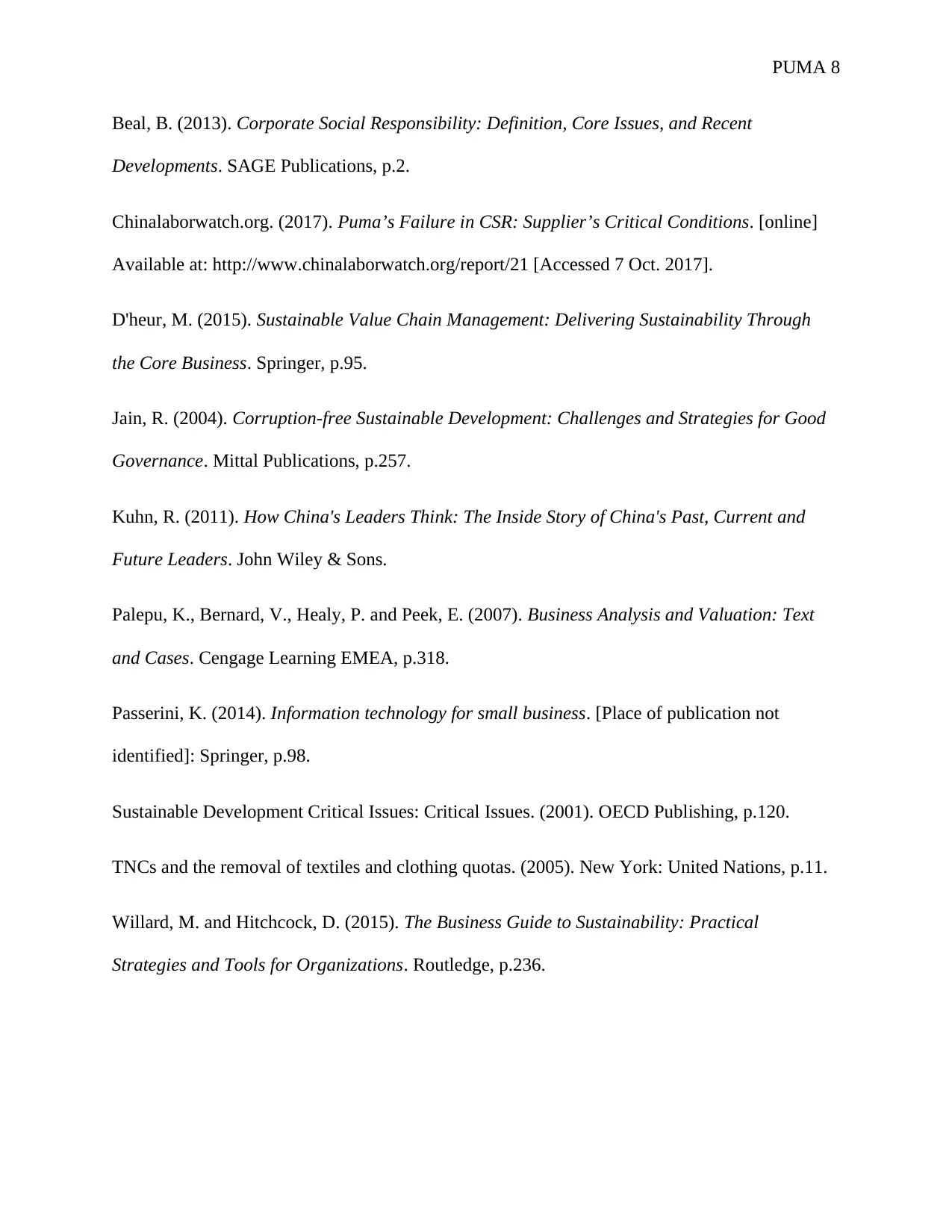
PUMA 8
Beal, B. (2013). Corporate Social Responsibility: Definition, Core Issues, and Recent
Developments. SAGE Publications, p.2.
Chinalaborwatch.org. (2017). Puma’s Failure in CSR: Supplier’s Critical Conditions. [online]
Available at: http://www.chinalaborwatch.org/report/21 [Accessed 7 Oct. 2017].
D'heur, M. (2015). Sustainable Value Chain Management: Delivering Sustainability Through
the Core Business. Springer, p.95.
Jain, R. (2004). Corruption-free Sustainable Development: Challenges and Strategies for Good
Governance. Mittal Publications, p.257.
Kuhn, R. (2011). How China's Leaders Think: The Inside Story of China's Past, Current and
Future Leaders. John Wiley & Sons.
Palepu, K., Bernard, V., Healy, P. and Peek, E. (2007). Business Analysis and Valuation: Text
and Cases. Cengage Learning EMEA, p.318.
Passerini, K. (2014). Information technology for small business. [Place of publication not
identified]: Springer, p.98.
Sustainable Development Critical Issues: Critical Issues. (2001). OECD Publishing, p.120.
TNCs and the removal of textiles and clothing quotas. (2005). New York: United Nations, p.11.
Willard, M. and Hitchcock, D. (2015). The Business Guide to Sustainability: Practical
Strategies and Tools for Organizations. Routledge, p.236.
Beal, B. (2013). Corporate Social Responsibility: Definition, Core Issues, and Recent
Developments. SAGE Publications, p.2.
Chinalaborwatch.org. (2017). Puma’s Failure in CSR: Supplier’s Critical Conditions. [online]
Available at: http://www.chinalaborwatch.org/report/21 [Accessed 7 Oct. 2017].
D'heur, M. (2015). Sustainable Value Chain Management: Delivering Sustainability Through
the Core Business. Springer, p.95.
Jain, R. (2004). Corruption-free Sustainable Development: Challenges and Strategies for Good
Governance. Mittal Publications, p.257.
Kuhn, R. (2011). How China's Leaders Think: The Inside Story of China's Past, Current and
Future Leaders. John Wiley & Sons.
Palepu, K., Bernard, V., Healy, P. and Peek, E. (2007). Business Analysis and Valuation: Text
and Cases. Cengage Learning EMEA, p.318.
Passerini, K. (2014). Information technology for small business. [Place of publication not
identified]: Springer, p.98.
Sustainable Development Critical Issues: Critical Issues. (2001). OECD Publishing, p.120.
TNCs and the removal of textiles and clothing quotas. (2005). New York: United Nations, p.11.
Willard, M. and Hitchcock, D. (2015). The Business Guide to Sustainability: Practical
Strategies and Tools for Organizations. Routledge, p.236.

PUMA 9
⊘ This is a preview!⊘
Do you want full access?
Subscribe today to unlock all pages.

Trusted by 1+ million students worldwide
1 out of 9
Your All-in-One AI-Powered Toolkit for Academic Success.
+13062052269
info@desklib.com
Available 24*7 on WhatsApp / Email
![[object Object]](/_next/static/media/star-bottom.7253800d.svg)
Unlock your academic potential
Copyright © 2020–2025 A2Z Services. All Rights Reserved. Developed and managed by ZUCOL.
